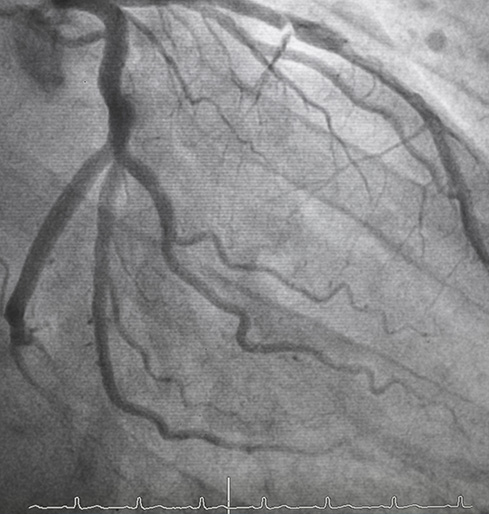Procedural Lab
At Cardiovascular Medicine, we want to make care as convenient as possible. To this end, we offer several in-office peripheral vascular services in our state-of-the-art procedural lab. Our lab features one of the most technologically advanced vascular imaging systems available in an office setting. Using high-tech equipment, our experienced cardiovascular physician specialists can detect and treat peripheral vascular disease on an outpatient basis.
When to See an Interventional Cardiologist
Peripheral vascular conditions occur when your peripheral arteries are narrowed or blocked, resulting in a lack of adequate blood flow. This can lead to painful symptoms, as well as put you at risk for serious complications such as amputation or stroke. Therefore, if you are at risk for peripheral arterial disease or are experiencing possible symptoms, it’s important to make an appointment to explore what’s going on. We can assess:

Diagnostic Testing
To examine your peripheral arteries, we use angiography, an imaging technique that uses X-ray and contrast dye to see how efficiently blood is flowing. The contrast dye provides improved visualization so we can identify areas of narrowing or blockage. We use minimally-invasive procedures to detect abnormalities in your extremities and kidneys, including:
Peripheral Vascular Treatments
We are proud to offer peripheral vascular services in-office to treat your narrowed or blocked peripheral arteries. By providing these services in our office, our patients experience the convenience of a safe, accessible environment, along with a predictable schedule and a lower cost. Our procedures are minimally-invasive and allow you to return to your normal activities sooner. Discover more about our procedural lab treatments.
Peripheral Angioplasty
What is Peripheral Angioplasty?
Your peripheral arteries carry oxygen-rich blood to your arms, legs, and extremities, and when the arteries that carry this blood are narrowed or clogged, blood flow is reduced, which can put you at risk for serious complications. When lifestyle changes and medications alone aren't enough to mitigate this risk, we may recommend a peripheral angioplasty.
Peripheral angioplasty uses a tiny balloon catheter to widen blood vessels and improve blood flow for the peripheral parts of the body, such as the legs, arms, or renal arteries. To ensure the blood vessels stay open, we may also insert a stent. A stent is a small wire mesh tube that helps prop the artery open to prevent it from narrowing again.
A peripheral angioplasty is designed to treat the buildup of plaque on blood vessel walls, a condition known as atherosclerosis. We are able to diagnose this condition with screening tests, such as a peripheral angiogram.
What to Expect
A peripheral angioplasty is a minimally-invasive outpatient procedure that could take several hours, depending on how many blockages we’re treating.
First, you will lay down on a procedure table and using an IV we'll administer sedatives, if necessary. Using an artery in your arm, leg, or groin area, we will introduce a catheter through a small puncture.
Contrast dye is injected to visualize areas that have narrowing. To fix areas with narrowing, we will guide a catheter through the artery. Using a balloon and/or stent we will open the artery. The balloon inflates to open the narrowing and deflates and is removed from the artery. Stents expand and lock into place and hold the artery open. This will improve blood flow.
Recovery
After your peripheral angioplasty, you will rest in our recovery room for a few hours under careful observation. Drink plenty of water to flush out the contrast dye. You should be able to resume most normal activity a week after the procedure.
Most patients notice significant improvements in how you feel after having a peripheral angioplasty. Our goal is to ease symptoms of pain and discomfort and decrease your risk of heart attack and stroke by slowing down the progression of atherosclerosis. However, having a peripheral angioplasty doesn't eliminate your risk for peripheral arterial disease. Continue to take your medications and be proactive about living a healthy lifestyle, which includes:
- Getting regular exercise
- Lowering your cholesterol
- Eating a healthy diet low in saturated fat
- Maintaining a healthy weight
- Quitting smoking
Risks & Side Effects
Angioplasty uses X-ray and contrast dye to identify narrowing in your arteries, which means you will be exposed to a small amount of radiation. The risk from X-rays increases with each exposure. Procedures that use X-rays are not recommended during pregnancy.
Am I a Candidate?
If you have been diagnosed with atherosclerosis or peripheral arterial disease, you may be a candidate for peripheral angioplasty. Symptoms that could indicate you are having issues with your peripheral arteries include:
- Leg numbness or weakness, discomfort, pain, or cramping with activity
- Heavy feet/legs
- Erectile dysfunction
- Slow toenail or leg hair growth
- Burning or aching in your toes while resting
- Cold legs or feet compared to the other limb
- Wounds and sores that won’t heal
- High blood pressure
- Swelling in your body's tissues
More on Peripheral Angioplasty
Uncommon Risks and Side Effects
Though complications are rare, there are some risks with peripheral angioplasty. They may include:
- Bleeding
- Blood clots
- Re-narrowing of the artery
- Kidney failure from the contrast dye
- Allergic reaction to the contrast dye
- Breathing problems
- Infection
- Rupture of your artery
Factors That Increase Your Risk of Peripheral Arterial Disease
There are certain factors that increase your risk of developing peripheral arterial disease. These include:
- Smoking, the most prominent risk factor
- High cholesterol
- High blood pressure
- Obesity
- Older age
- Being male
- Family history of heart or blood vessel disease
Meet Your Illinois and Iowa
Cardiovascular Physicians
CVM Locations
Insurance Providers We Accept
In Search of Care? Request a Consultation Today



